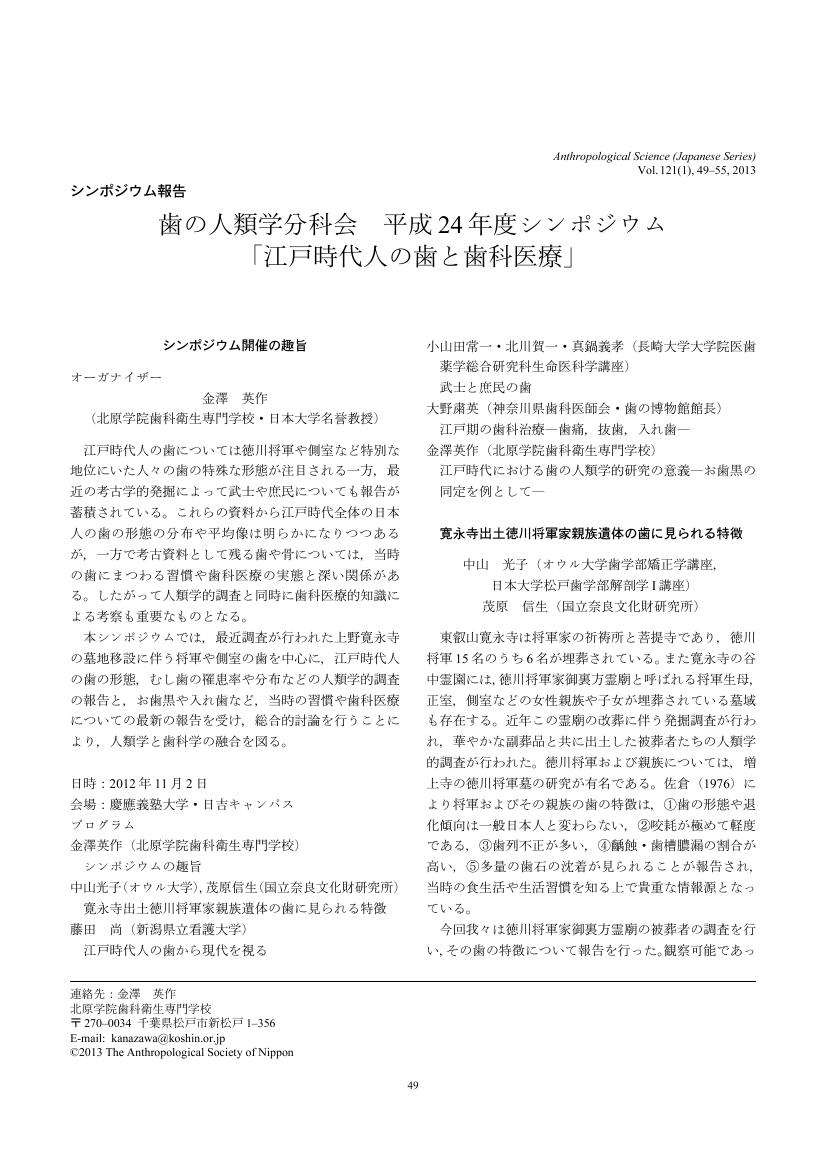3 0 0 0 OA 歯の人類学分科会 平成24年度シンポジウム「江戸時代人の歯と歯科医療」
2 0 0 0 IR 頭蓋骨折をともなうペルー先住民の頭蓋穿孔(Trepanation)について
- 著者
- 加藤 克知 イルダ ビダル 篠田 謙一 真鍋 義孝 北川 賀一 小山田 常一 六反田 篤
- 出版者
- 長崎大学
- 雑誌
- 長崎大学医学部保健学科紀要 (ISSN:09160841)
- 巻号頁・発行日
- vol.15, no.2, pp.13-17, 2002-12
頭蓋骨折と思われる傷痕を有するインカ時代ペルー先住民のTrepanation(頭蓋穿孔)施術頭蓋3例を観察し,骨折痕と頭蓋穿孔の関連について考察した.頭蓋穿孔痕は,一例は骨折受傷部と異なる部位に,残り2例は骨折受傷部に一致して存在した.これらの観察から得られた所見は,頭蓋穿孔が何らかの治療的意図を持って骨折痕に対してとられた処置であることを示唆する.すなわち,特にインカ時代は戦闘行為による頭蓋骨折発生頻度の高い時期であり,当時人々は頭蓋穿孔が骨折受傷後の状態や予後の改善に有効であることを経験的に認識していたと考えられる.Three trepanned skulls with fracture traces in ancient Peru (Inca period) were presented, and whether the trepanations were intended to the fracture lesions or the following symptom was briefly discussed. The skull fractures, probably resulting from violence, was located in the frontal or parietal regions. In one case, the trepanations were performed in different regions from the fracture lesions, and in other two cases the operations were probably done at the correspondent regions to the lesions. The observation on these skulls suggests the possibility of trepanations as an intended therapeutic procedure of the skull fractures in Inca period of Peru, where people might frequently experienced the traumatic injuries by violence such as the fight.
- 著者
- 坂本 淳哉 真鍋 義孝 弦本 敏行 本田 祐一郎 片岡 英樹 中野 治郎 沖田 実
- 出版者
- 公益社団法人 日本理学療法士協会
- 雑誌
- 理学療法学Supplement Vol.43 Suppl. No.2 (第51回日本理学療法学術大会 抄録集)
- 巻号頁・発行日
- pp.0517, 2016 (Released:2016-04-28)
【はじめに,目的】股関節疾患患者では患部を起源とした関連痛が膝関節前面にみられることが多く,その発生機序の仮説の一つとして二分軸索感覚ニューロンの関与が考えられているが,この点に関する解剖学的な根拠はこれまでに十分に示されていない。一般に,股関節および膝関節前面の知覚は大腿神経ならびに閉鎖神経から分岐する関節枝が支配するとされているが,これらの関節枝の分布状況を同時に検討した報告はこれまでになく,前述したような関連痛の発生機序を明らかにするためには股関節枝と膝関節枝の分布状況を同時に検討する必要がある。そこで,本研究では日本人遺体における大腿神経ならびに閉鎖神経から分岐する股関節枝および膝関節枝の分布状況について検討した。【方法】対象は平成24年度ならびに平成26年度に所属大学の歯学部人体解剖学実習に供された日本人遺体9体9肢(男性5体,女性4体,右側1肢,左側8肢)で,各遺体における大腿神経および閉鎖神経から分岐する股関節枝と膝関節枝を剖出・観察した。なお,観察は所属大学内の定められた解剖学実習室でのみ行い,実習室の管理者の管理・指導のもと,礼意を失わないように実施した。【結果】大腿神経から分岐する股関節枝には①恥骨筋枝から分岐して前内側に達する枝(4肢,44.4%),②腸骨筋枝から分岐して前外側に達する枝(3肢,33.3%)が認められ,閉鎖神経から分岐する股関節枝には①前枝から分岐して股関節前内側に達する枝(3肢,33.3%),②後枝から分岐して股関節前内側に達する枝(2肢,22.2%)が認められた。一方,大腿神経から分岐する膝関節枝には①内転筋管内を下行した後に膝蓋骨内側に達する枝(2肢,22.2%),②内側広筋枝から分岐して膝蓋骨内側に達する枝(5肢,55.6%),③膝関節筋枝から分岐して膝蓋上包に達する枝(6肢,66.7%),④外側広筋枝から分岐して膝蓋骨外側に達する枝(1肢,11.1%)が認められた。また,閉鎖神経から分岐する膝関節枝は前枝から分岐して伏在神経と併走して膝蓋骨下内方に達する枝(1肢,11.1%)が認められた。加えて,各遺体における分布状況を検討したところ,大腿神経の恥骨筋枝から分岐して股関節前内側に達する枝と内側広筋を貫通して膝関節前内側に達する枝を同時にもつ所見が3体で認められた。【結論】以上の結果から,股関節および膝関節の前面は主に大腿神経から分岐する関節枝により支配されることが明らかになった。そして,先行研究を参考にすると,股関節および膝関節の前内側を大腿神経が同時に支配している所見は両関節を支配する二分軸索感覚ニューロンの存在を示す肉眼解剖学的所見とも考えられ,股関節を起源とした膝関節の痛みの発生に関与している可能性が推察される。
1 0 0 0 歯の形態からみた南西諸島住民の地域的変異
南西諸島における集団史を探るため、地域的変異の調査を続けている。本年度は、南西諸島の南端近くに位置している石垣島に居住する若年者(男64名・女86名)の歯冠に出現する非計測的形質の頻度を調査した。17形質のうち日本の在来系集団と渡来系集団で特に明瞭な差を示す12形質の出現頻度について、日本列島における各時代の12集団と比較した。その結果、石垣島現代人において在来系的特徴を示す形質はわずかに屈曲隆線(LM1)だけであるが、シャベル型(UI1)、斜切痕(UI2)、第5咬頭(UM1)、4咬頭性(LM2)、プロトスタイリッド(LM1)の比較的多くの形質では渡来系的であった。また、ダブルシャベル型(UI1)、舌側面近心辺縁隆線(UC)、舌側面遠心副隆線(UC)、カラベリ形質群(UM1)、Y型咬合面溝(LM2)、第6咬頭(LM1)の多くの形質では在来系と渡来系の中間的特徴を示していた。さらに多変量解析を適用すると、石垣島現代人は沖縄本島と種子島の現代人に最も近く、南西諸島内の地域的変異はかなり小さいことが明らかになった。これらの南西諸島の3集団は1つのクラスターを形成し、東アジアの中では東北アジア型と東南アジア型の境界領域に位置していたが、日本列島の集団の中では在来系よりも渡来系集団に圧倒的に近く位置していた。また、南西諸島の中で厳密に比較すると、種子島が石垣島や沖縄本島よりもやや東北アジア型に近く位置していた。これらの結果は、現代人に限定した場合の「アイヌ・琉球同系説」を否定する。ところが、種子島における時代的変化を考慮に入れた場合、沖縄本島の先史時代にも在来系集団が存在していたと想定され、その後に渡来系遺伝子の流入が起こった可能性を示唆するものである。南西諸島内の地域的変異は小さなものであったが、厳密な比較で認められた南西諸島内における南北のクラインは、渡来系遺伝子の流入が北から起こった可能性を示唆している。
1 0 0 0 先インカ〜インカ帝国形成期におけるアンデス先住民の人類学的研究
インカによる統一以前のアンデスには、多数の地域国家が存在した。これらは生業形態や地理的環境から大きく海岸地帯と山岳地域または南部と北部に分類することができる。今回の研究では、かつてこれらの地域に存在した集団の遺伝的な関係と、集団内部の血縁関係を考察する目的で、骨と歯の形態学的な研究と人骨から抽出したDNAを解析した。4年間の研究で、ペルー北海岸では紀元前後から11世紀までの遺跡、アンデスの山岳地域ではインカ時代の遺跡、そして南部の海岸地域では紀元前後から7世紀にかけての遺跡を調査して、合計で2百体以上の人骨の研究を行うことができた。得られたサンプルに対し、形態学的な研究からは、各集団の歯の形態学的な特徴の抽出、頭蓋骨の形態学的な研究、そして頭蓋変形と開頭術の時代的な変遷についての解析を行った。また、DNA分析では、抽出したDNAを用いてPCR法でミトコンドリアDNAのD-loop領域とcoding領域の一部を増幅した。この塩基配列データ解析することによって、遺跡内部での血縁関係の追求と、周辺遺跡との系統的な関係についての考察を行った。北海岸のシカンの遺跡では、埋葬された人物間の血縁関係をDNA分析によって推定し、歯の形態学的な研究結果や考古学的な証拠と併せて考察を行った。また、モチェとガイナッソの遺跡を研究し、双方の関係について考察した。それらの知見と考古学的な証拠とを総合的に判断した結果、基本的には北海岸と南の海岸及び山岳地域とは、集団の構成に違いがあることが明らかとなった。また、アンデスのウルバンバ川周辺の遺跡のDNA解析からは、現代の先住民につながる人々がこの時代から居住していたことが明らかにした。
1 0 0 0 北部九州人の頭顔部と歯列弓との相関について
- 著者
- 六反田 篤 真鍋 義孝 村上 守良 伊東 励
- 出版者
- 九州歯科学会
- 雑誌
- 九州齒科學會雜誌 : Kyushu-Shika-Gakkai-zasshi (ISSN:03686833)
- 巻号頁・発行日
- vol.37, no.2, pp.479-484, 1983-04-25
- 被引用文献数
- 2
The authors conducted the somatological measurement of head and face, and the impression taking of the upper and lower dental arches on 85 adults who lived in North Kyushu Region. After examining the correlations between the measured values of the head and face, and the dental arch, we have reached the following conclusions : 1. In terms of lengths, there is a positive correlation in the total of males and females, between head length and upper dental arch length. 2. In terms of lengths and heights, there is a positive correlation in the total of males and females, between head length and palatal vault height. 3. In terms of breadths, there is a positive correlation in the males and the total of males and females, between head breadth and upper and lower dental arch breadth, between bizygomatic breadth and upper and lower dental arch breadth, and between bigonial breadth and upper and lower dental arch breadth. 4. In terms of breadths and lengths, there is a positive correlation in the males, between bizygomatic breadth and lower dental arch length, in the females, between head breadth and upper dental arch length, between bizygomatic breadth and lower dental arch length, in the total of males and females, between head breadth and upper and lower dental arch length, between bizygomatic breadth and upper and lower dental arch length. 5. In the terms of breadths and heights, there is a positive correlation in the males, between bizygomatic breadth and palatal vault height, in the total of males and females, between head breadth and palatal vault height, between bizygomatic breadth and palatal vault height. 6. In the terms of heights, there is a positive correlation in the males, between auricular height and palatal vault height, in the females, between morphological face height and palatal vault height, in the total of males and females, between auricular height and palatal vault height, between morphological face height and palatal vault height. 7. In terms of heights and lengths, there is a positive correlation in the females and the total of males and females, between morphological face height and upper and lower dental arch length. 8. In terms of heights and breadths, there is a positive correlation in the males, between morphological face height and upper dental arch breadth, in the females, between morphological face height and upper and lower dental arch breadth, in the total of males and females, between auricular height and upper dental arch breadth, between morphological face height and upper and lower dental arch breadth. As descrived in the above, the correlation between the head and the face, and the dental arch showed more positive results in the maxilla than in the mandible, and more positive results in the face than in the head. The Person in North Kyushu Region was more balanced between the head and the face, and the dental arch than in the Person of Miiraku and Katumoto.
- 著者
- 真鍋 義孝
- 出版者
- 九州歯科学会
- 雑誌
- 九州齒科學會雜誌 : Kyushu-Shika-Gakkai-zasshi (ISSN:03686833)
- 巻号頁・発行日
- vol.43, no.3, pp.489-522, 1989-06-25
- 被引用文献数
- 14
Nineteen tooth crown traits of Yami tribe, Taiwan Aborigine, were examined and compared with 16 East Asian populations in order to clarify an anthropological position of Yami based on Mongoloid dental variations. In the eight traits which show considerable difference between Sinodonty which is typical of Northeast Asia, and Sundadonty which is typical of Southeast Asia, shoveling (UI1), Y-groove (LM2) and deflecting wrinkle (LM1) of Yami were similar to those of Sinodonty, while winging (UI1), cusp 5 (UM1) and Carabelli's trait (UM1) of Yami were similar to those of Sundadonty. Double shovel (UI1) and 4-cusp (LM2) of Yami lie midway between Sinodonty and Sundadonty. Two major clusters were obtained from a cluster analysis on Smith's MMD among 16 East Asian populations and Yami, based on 19 crown traits. One was a Sinodonty cluster, and the other was a Sundadonty cluster. Yami was included in the Sinodonty cluster. Furthermore, the principal co-ordinate anlysis showed that Yami, in Sinodonty, was nearest to Sundadonty, in contrast to typical Sinodonty. Judging from the above analyses, it was proved that the dentition of Yami was characteristic of both Sinodonty and Sundadonty, and had more resemblance, if anything, to Sinodonty rather than to Sundadonty.

